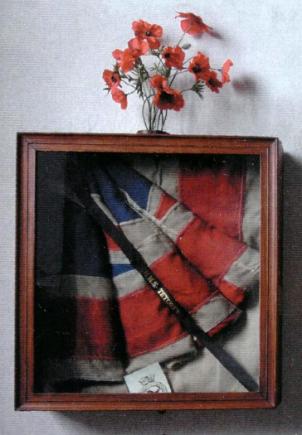HMS TETCOTT'S WHITE BATTLE ENSIGN
The rediscovery of HMS Tetcott’s White Ensign which now sits in a purpose-made case on the wall of the South Chapel of Tetcott Church can be said to be the catalyst from which the HMS Tetcott Project was born.
It is well-known that the Royal Navy has always flown Battle Ensigns when in action: numerous, big flags, from various parts of the ship. The tradition originally began in the days of the sailing navy, to ensure that at least one flag would continue to fly should the rigging be damaged, because showing no ensign was a signal that the ship had surrendered.

A chance discovery of a newspaper article - reporting on the visit to Tetcott of Lieutenant Commander Rycroft, Sub Lieutenant Miles Dawson, and eight ratings in 1941 - led to an investigation by author Shawn Dymond and church warden Bill Cloke which would eventually lead to the restoration and rededication of the ensign.
A letter written by Commander Rycroft after his visit to Tetcott, tells the story of the presentation of the ensign to the church –
“The presentation was preceded by a parade of the Home Guard and my men, with myself in charge – an army band failed to turn up in time. The service began with myself coming up the tiny nave with a White Ensign on a staff, stopping just short of the altar rails.
Then the organ kicked off with the National Anthem, after which I handed the ensign to the rector, who laid it on the altar rails, blessing it and the ship. The Sunday morning service then followed, with appropriate hymns and the 144th Psalm. The church was packed to the roof with 120-odd people out of a population of about 200, which is not bad. St Aubyn and I read the lessons and afterwards we drank sherry at the Manor House."
At the close of the war it appears that the ensign had been folded up and forgotten about until being rediscovered in 1994. Displayed once more, it was evident that, without conservation, the ensign was likely to deteriorate further and, through a generous contribution by the Mr Robert Davenport (whose father, Dudley Davenport had been HMS Tetcott's First Lieutenant on commissioning in December 1941) a purpose-built cabinet was made, and in the year 2000, the ensign was rededicated and was returned to its rightful place in Tetcott Church.